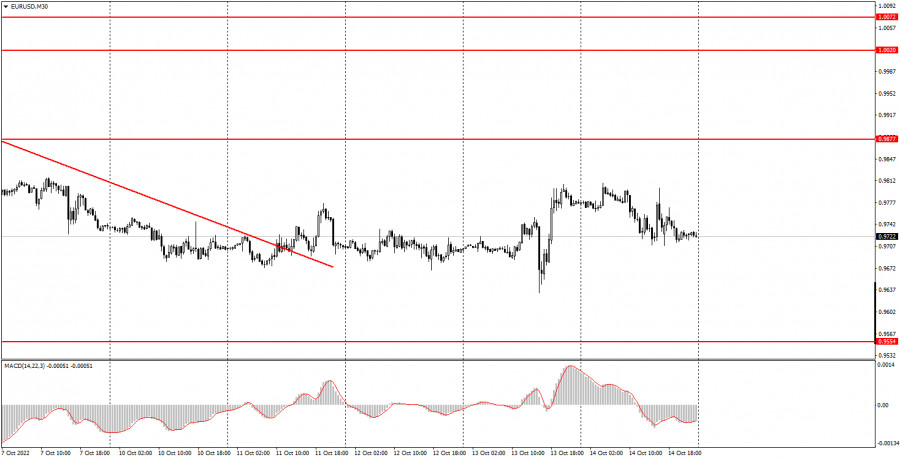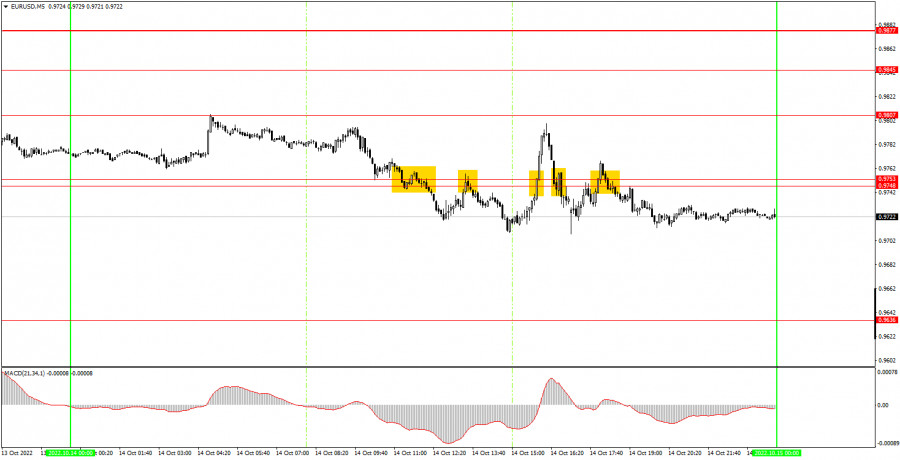Analysis of Friday's deals: 30M chart of the EUR/USD pair

The EUR/USD currency pair continued to trade mostly sideways on Friday. In general, the pair spent the entire current week in horizontal movement. Of course, the downward bias of the movement took place on Friday, but in general it is flat. The market only managed to fully work out the US inflation report on Friday, which turned out to be very resonant, although its value practically did not differ from either the forecast or the previous value. However, sometimes the lack of change is in itself grounds for a strong reaction. Recall that the consumer price index fell in September by only 0.1% to 8.2% y/y. Since the Federal Reserve has been raising the key rate quite aggressively for a long time, the market was, to put it mildly, disappointed by this value. But at the same time, the virtual absence of a new slowdown in US inflation means that the Fed will continue to aggressively tighten monetary policy. And this is already a factor in favor of the US dollar. Thus, the first conclusion: the US currency retains the highest chances of growth against the euro. The second conclusion: at the Fed's next meeting, we will see a new rate hike of 0.75%. As the euro continues to trade near its 20-year lows, we believe that the global downward trend will resume again.
5M chart of the EUR/USD pair

The movement on the 5-minute timeframe on Friday was the most difficult. If a day earlier two levels were reached perfectly and made it possible for traders to make good money, then on Friday the pair drew a "fence". As a result, the 0.9748-0.9753 area was overcome several times, each time a corresponding signal was formed. Let's see what we can do. The first signal to sell made it possible to go down 17 points. Therefore, Stop Loss should have been set to breakeven. The price returned to the level of 0.9753, so the Stop Loss was triggered, but the bounce from this level was another sell signal, which also had to be worked out. This time the price went down already 26 points, so novice players again had to set Stop Loss to breakeven, and the price again returned to the level of 0.9753. Since two blatantly false signals had already been formed by this moment, all subsequent ones near the area of 0.9748-0.9753 should not have been worked out. As a result, there was no profit on Friday.
How to trade on Monday:
The pair maintains a downward trend on the 30-minute timeframe, despite consolidating above the descending trend line, but at the same time it has been trading in an absolute flat for five days already. It is inconvenient to trade right now. We believe that the pair may continue to move lower and renew its 20-year lows in the near future. The euro once again shows its unpreparedness for serious growth. On the 5-minute TF tomorrow it is recommended to trade at the levels of 0.9554, 0.9636, 0.9748-0.9753, 0.9807, 0.9845, 0.9877, 0.9952. When passing 15 points in the right direction, you should set Stop Loss to breakeven. Neither the EU nor the US is scheduled for a single important event or report. Thus, there will be nothing to react to during the day, and the flat may continue for the sixth consecutive day.
Basic rules of the trading system:
1) The signal strength is calculated by the time it took to form the signal (bounce or overcome the level). The less time it took, the stronger the signal.
2) If two or more deals were opened near a certain level based on false signals (which did not trigger Take Profit or the nearest target level), then all subsequent signals from this level should be ignored.
3) In a flat, any pair can form a lot of false signals or not form them at all. But in any case, at the first signs of a flat, it is better to stop trading.
4) Trade deals are opened in the time period between the beginning of the European session and until the middle of the US one, when all deals must be closed manually.
5) On the 30-minute TF, using signals from the MACD indicator, you can trade only if there is good volatility and a trend, which is confirmed by a trend line or a trend channel.
6) If two levels are located too close to each other (from 5 to 15 points), then they should be considered as an area of support or resistance.
On the chart:
Support and Resistance Levels are the Levels that serve as targets when buying or selling the pair. You can place Take Profit near these levels.
Red lines are the channels or trend lines that display the current trend and show in which direction it is better to trade now.
The MACD indicator (14,22,3) consists of a histogram and a signal line. When they cross, this is a signal to enter the market. It is recommended to use this indicator in combination with trend lines (channels and trend lines).
Important speeches and reports (always contained in the news calendar) can greatly influence the movement of a currency pair. Therefore, during their exit, it is recommended to trade as carefully as possible or exit the market in order to avoid a sharp price reversal against the previous movement.
Beginners on Forex should remember that not every single trade has to be profitable. The development of a clear strategy and money management are the key to success in trading over a long period of time.
Trading analysis offered by Flex EA.
Source



Please do not spam; comments and reviews are verified prior to publishing.